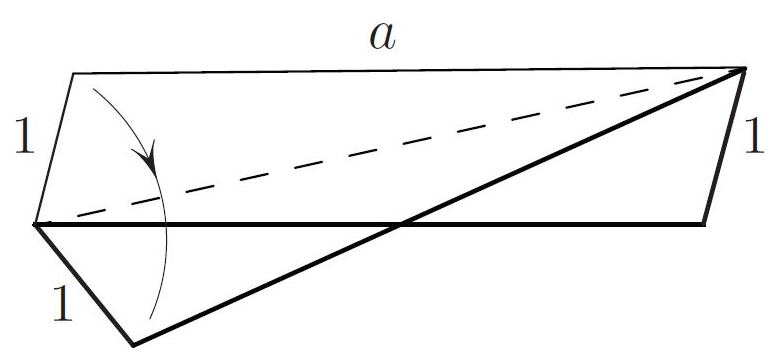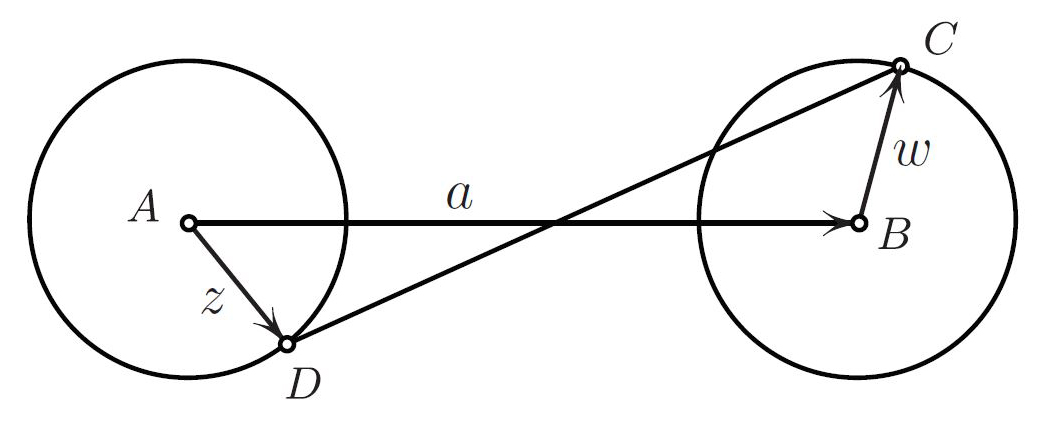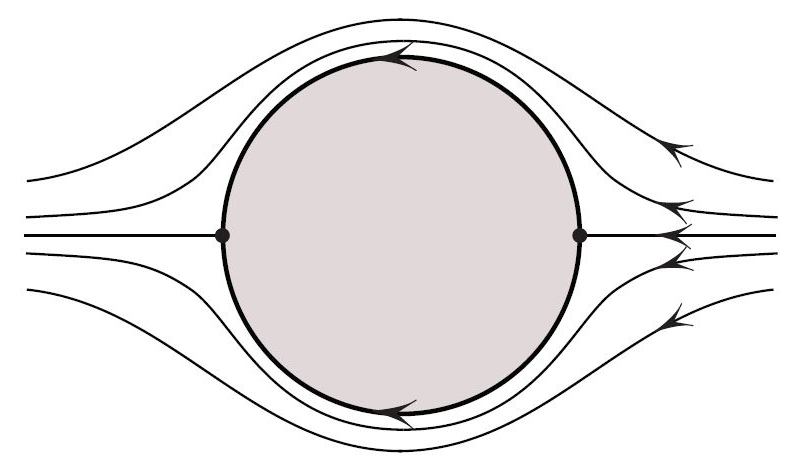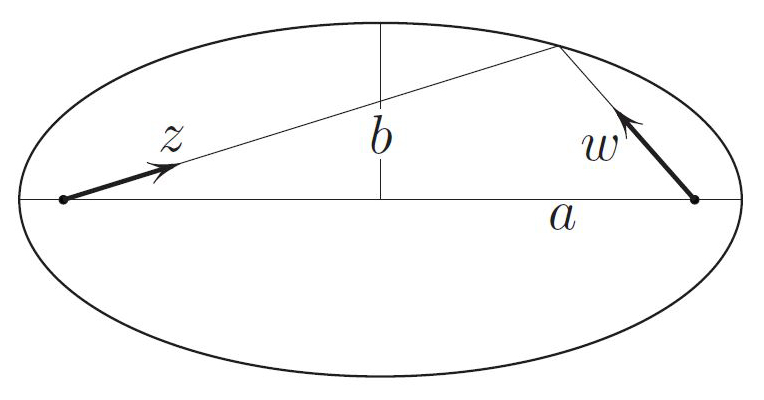Möbius Map in Hinges, Bikes, Fluids, and Ellipses
The Möbius map
\[z\mapsto w=e^{i \alpha} \frac{z-c}{1-\overline c z}, \tag1\]
the linear fractional transformation leaving the unit circle \(| z | =1\) invariant, is present in every course on complex analysis. Interestingly, this same map arises in other contexts, four of which I describe here.
1. A “Locomotive” Map

Consider a parallelogram whose sides are rods of lengths \(1\) and \(a>1\) (see Figure 1). Fold the parallelogram along the dotted diagonal to obtain a “butterfly” figure in the plane (see Figure 2). Imagine that each vertex is a hinge; fixing the segment \(AB\) and rotating \(AD\) will cause \(BC\) to rotate (in the opposite direction), vaguely reminiscent of a locomotive. \(D\)'s position on the circle uniquely determines \(C\)'s position on its own circle. We thus have the map of a circle to itself (identifying the two circles). Remarkably, this map is a Möbius map — up to a reflection. More precisely, if we treat \(AD=z\) and \(BC=w\) as complex numbers on the unit circle with \(AB\) along the \(x\)-axis, then

\[w = \overline {\biggl( \frac {z-a}{1-az} \biggl)}, \]
a special case of \((1)\), up to the conjugation. A short proof of this is available in [1].
2. The “Bicycle”
The bicycle in Figure 3 is a segment of fixed length moving in the plane in such a way that the velocity of the “rear” endpoint constrains to the segment’s line (there is no sideslip), while the “front” endpoint moves along a prescribed path \(\Gamma\). Fixing \(\Gamma\) once and for all, the starting orientation determines the final orientation; that is, we have a circle map (see Figure 3). Robert Foote observed that it is actually a Möbius map [2], i.e., it is given by \((1)\). The constants \(\alpha\) and \(c=a+ib\) depend on the front path \(\Gamma\) but not on the bike’s initial orientation.

3. The Fluid
Imagine a cylinder guided through ideal fluid (i.e., one with vanishing curl and divergence) in an arbitrarily-prescribed path; Figure 4 shows a snapshot of the fluid velocity field in the cylinder’s reference frame. Particles on the boundary of the cylinder slide on the surface (the ideal fluid does not stick to walls). We thus have a map from the particle’s initial position on the circle to its ending position. This map also turns out to be of the Möbius form \((1)\), with \(\alpha\) and \(c\) dependent upon the cylinder’s path through the fluid. Incidentally, Figure 4 illustrates the zero circulation case, but the statement remains true for nonzero circulation as well.

4. An Ellipse
The unit vectors \(z\) and \(w\) (treated as complex numbers) in Figure 5 are related by the Möbius transformation \((1)\), where \(\alpha = 0\) and
\[c= \sqrt{ 1- \frac{b ^2 }{a ^2 } };\]
here \(a\) and \(b\) are the minor and major semiaxes of the ellipse. This fact occurred to me as I was writing the article, although I am sure it has been observed before.
5. A Note on the Explanation

Facts 2, 3, and 4 follow from the observation on the circle’s simplest nontrivial flow, given by
\[\dot \theta = \sin \theta.\]
Namely, the time advance map of this flow acts on points \(e^{i\theta}\) as a Möbius map. This can be shown by a quick geometrical argument or short calculation (both omitted). The “Möbiusness” of the time advance map survives the addition of rotation and time-dependence
\[\dot \theta = p(t) +q(t) \sin \theta,\]
for any continuous \(p\), \(q\). One can deduce this latter fact from the preceding remark and the fact that Möbius transformations form a group under composition.
Facts 1 and 4 are shown by calculation. To end on a sad note, I am not aware of their geometrical proof.
The figures in this article were provided by the author.
References
[1] Bor, G., Levi, M., Perline, R., & Tabachnikov, S. (2018). Tire tracks and integrable curve evolution. Preprint, arXiv:1705.06314. To appear in Int. Math. Res. Not.
[2] Foote, R. (1998). Geometry of the Prytz planimeter. Rep. Math. Phys., 42, 249-271.
About the Author
Mark Levi
Professor, Pennsylvania State University
Mark Levi (levi@math.psu.edu) is a professor of mathematics at the Pennsylvania State University.
Stay Up-to-Date with Email Alerts
Sign up for our monthly newsletter and emails about other topics of your choosing.



